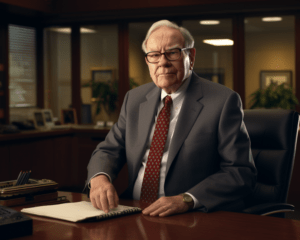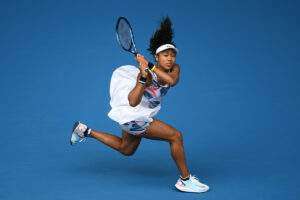Warren Buffett, the renowned investor and business magnate, has an awe-inspiring journey from humble beginnings to becoming one of the wealthiest people in the world. Born on August 30, 1930, in Omaha, Nebraska, Buffett’s early life hinted at his future business acumen and entrepreneurial spirit. As a young boy, he began selling newspapers and door-to-door chewing gum, showcasing his innate talent for identifying business opportunities and earning money.
Early Years and Entrepreneurial Spirit
Once upon a time, in the quiet town of Omaha, Nebraska, a young boy named Warren Buffett roamed the neighborhood, his mind constantly brimming with ideas for making a few extra pennies. With a heart full of ambition and a keen eye for spotting opportunities, Warren’s entrepreneurial journey began at a tender age.
One sunny afternoon, while taking a leisurely stroll near the local golf course, Warren noticed a common sight – golf balls scattered across the grass, abandoned by careless golfers. An idea struck him like a bolt of lightning: why not collect these golf balls, clean them up, and sell them back to golfers at a fraction of the price of new ones?
The next morning, armed with a bucket and a determination that belied his young age, Warren set out on his mission. Each morning, he would scour the golf course grounds, hunting for stray golf balls hidden among the bushes and trees. With unwavering perseverance, he collected dozens of balls and took them home to give them a meticulous scrubbing until they sparkled like new.
Warren would then clean up those used golf balls, and resell them to golfers at a bargain price. As Warren’s golf ball business flourished, he realized the importance of reinvesting his earnings. He purchased more cleaning supplies and improved his display, making his products more appealing to potential customers. With a touch of charm and an infectious smile, he won over the hearts of golfers who admired his determination and ingenuity.
But young Warren was not content with merely selling golf balls. Always seeking new ventures, he expanded his soon found other businesses worth spending his efforts.
Pinball Machine Business in High School years
During his high school years, Warren Buffett, along with his friend recognized an opportunity in the growing popularity of pinball machines. They decided to start a business by buying a used pinball machine and placing it in a local barbershop in Omaha. The arrangement with the owner of the barbershop involved a profit-sharing agreement where they would receive a portion of the earnings generated by the machine, instead of having them needed to pay rent for those locations.
The pinball machine proved to be a great success, attracting many customers to the barbershop. This success encouraged Buffett and Danley to expand their business further. They reinvested their earnings to purchase more pinball machines and strategically placed them in other local businesses, such as cafeterias and stores. The popularity of these machines continued to grow, and soon, they had several pinball machines operating in multiple locations throughout Omaha.
As their pinball machine business flourished, the owner of the barbershop where their first machine was placed approached them with an offer. The owner expressed interest in buying the pinball machine outright. Instead of accepting the offer immediately, they saw an opportunity to negotiate a more favorable deal.
Understanding the potential for ongoing profits from the machine, they struck a clever agreement. Rather than selling the pinball machine outright, they negotiated a deal where they retained partial ownership of the machine while still receiving a share of its earnings. This arrangement allowed them to continue benefiting from its success, even after the sale. This decision showcased their business savvy and long-term vision.
By recognizing the opportunity in pinball machines, expanding their business strategically, and negotiating an advantageous deal, Buffett demonstrated his natural ability to seize opportunities and make sound business decisions. These early experiences laid the groundwork for his future success as a legendary investor and one of the most influential figures in the financial world.
The Graham Influence
Warren Buffett’s journey to becoming the legendary investor we know today began in the early 1950s when he enrolled at Columbia Business School. During this time, he attended a lecture by renowned economist and investor, Benjamin Graham. Graham’s lecture on value investing and his book “The Intelligent Investor” left a profound impact on the young Buffett. This encounter marked the beginning of a transformative mentorship that would shape Buffett’s investment philosophy.
Impressed by Graham’s teachings, Buffett sought to learn directly from the master. He applied to Columbia University’s PhD program to study under Graham. However, Graham turned him down, advising him to take a job at his investment firm, Graham-Newman Corporation, instead. Following Graham’s advice, Buffett graduated from Columbia and applied for a job at Graham’s firm.
In 1954, Warren Buffett joined Graham-Newman Corporation as an analyst. Under Graham’s tutelage, Buffett deepened his understanding of value investing. Graham’s approach emphasized the importance of thoroughly analyzing a company’s fundamentals, such as earnings, assets, and cash flow, to identify undervalued stocks. Graham’s concept of a “margin of safety” also became ingrained in Buffett’s investment philosophy – buying stocks at a significant discount to their intrinsic value to protect against downside risks.
During his time at Graham-Newman Corporation, Buffett absorbed invaluable lessons from Graham’s investment decisions. He saw firsthand how Graham employed a patient, long-term approach to investing and the discipline to hold stocks even when market sentiment fluctuated. These principles profoundly influenced Buffett’s approach to investing and laid the foundation for his future success.
Benjamin Graham’s Investment Philosophy – Value Investing
- Margin of Safety: Graham believed in the concept of a “margin of safety,” which means buying a stock at a price significantly below its intrinsic value. This approach was meant to protect investors from downside risk and provide a cushion in case of adverse market movements.
- Fundamental Analysis: Graham emphasized the importance of thorough fundamental analysis of a company’s financial statements and business prospects. He looked for companies with strong balance sheets, stable earnings, and a history of profitability.
- Mr. Market Analogy: Graham used the analogy of “Mr. Market” to describe the emotional and irrational behavior of the stock market. He encouraged investors to take advantage of market fluctuations rather than being swayed by them. Instead of following the market’s short-term sentiment, he advocated for a long-term perspective.
- Diversification: Graham believed in diversifying investments across multiple securities to spread risk. He recommended holding a basket of well-selected undervalued stocks to reduce the impact of any individual stock’s poor performance.
- Net-Net Investing: Graham sometimes engaged in “net-net” investing, which involved buying stocks trading at prices below their net current asset value (current assets minus total liabilities). This approach focused on deeply undervalued companies.
Warren Buffett’s Improvements and Differences
- Long-Term Investment Horizon: While both Graham and Buffett believed in buying undervalued stocks, Buffett extended the holding period. Graham’s approach could involve shorter holding periods once a stock reached its intrinsic value, but Buffett is known for his preference for long-term investments.
- Quality over Quantity: Buffett placed more emphasis on investing in high-quality companies with durable competitive advantages or “economic moats.” Instead of simply focusing on net-net investments, Buffett sought companies with long-term growth potential.
- Concentration of Investments: Unlike Graham’s recommendation for diversification, Buffett concentrated his investments in companies he understood well and had great confidence in. He believed in focusing on his “best ideas” rather than holding a large number of stocks.
- Management and Intangible Factors: While Graham primarily relied on financial statement analysis, Buffett considered qualitative factors, such as the quality of management and the company’s brand value. He recognized the importance of intangible aspects that could contribute to a company’s success.
- Buying Entire Companies: Later in his career, Buffett moved beyond solely buying undervalued stocks. He started acquiring entire companies, which allowed him to have greater control and influence over their operations.
Warren Buffett improved upon Benjamin Graham’s value investing philosophy by incorporating long-term investment horizons, focusing on high-quality companies, concentrating his investments in his best ideas, considering qualitative factors, and ultimately moving beyond stocks to buy entire companies. While Graham’s teachings provided the initial framework, Buffett’s adaptations and enhancements shaped his unique investment strategy and contributed to his unparalleled success as an investor and business magnate.
The First Big Investment
In 1962, Warren Buffett made a fateful investment that would forever alter the trajectory of his life and become one of the most significant decisions in his illustrious career.
At the time, Berkshire Hathaway was a textile manufacturing company based in New Bedford, Massachusetts. The company faced numerous challenges, including fierce competition from foreign textile manufacturers and a gradual decline in the domestic textile industry.
Despite Berkshire Hathaway’s difficulties, Warren Buffett recognized potential in the company’s underlying assets. The company’s management had historically reinvested earnings into new machinery and plants, and Buffett believed that these physical assets held considerable value.
In 1962, Warren Buffett began buying shares of Berkshire Hathaway stock. His initial purchases were priced at around $7.50 per share. Soon after, he accumulated enough shares to gain a significant stake in the company, making him one of the largest shareholders.
Buffett envisioned turning around Berkshire Hathaway by applying his investment philosophy, learned from his mentor Benjamin Graham. He intended to restructure the company’s operations and increase its efficiency, aiming to breathe new life into the struggling textile business.
However, despite Buffett’s best efforts, the textile business proved to be challenging to revitalize. The company continued to face headwinds and struggled to compete effectively. As a result, Buffett made the pivotal decision to shift Berkshire Hathaway’s focus away from textiles and toward a new direction.
Rather than sell off the company entirely, Buffett repurposed Berkshire Hathaway as an investment holding company. He began using the company’s excess capital to invest in other businesses and securities. This marked a significant shift in the company’s strategy, as it transformed from a textile manufacturer into a diversified conglomerate.
One of the hallmarks of Warren Buffett’s investment approach is his emphasis on long-term holdings. As Berkshire Hathaway evolved into an investment vehicle, Buffett maintained a long-term perspective, focusing on acquiring stakes in companies that he believed had strong growth potential and durable competitive advantages.
Under Buffett’s stewardship, Berkshire Hathaway thrived as an investment holding company. Over the years, the company made numerous acquisitions, including investments in Coca-Cola, American Express, and Geico, among others. These strategic investments, coupled with Buffett’s patient approach, allowed Berkshire Hathaway’s intrinsic value to soar.
Buffett’s success in managing Berkshire Hathaway’s investment portfolio earned him the moniker “The Oracle of Omaha.” His ability to consistently outperform the market and generate extraordinary returns for shareholders catapulted him to international fame as one of the world’s most successful investors.
Berkshire Hathaway
After Warren Buffett transformed Berkshire Hathaway into an investment holding company, he continued to make a series of iconic investments that cemented his reputation as a legendary investor. Two notable examples that exemplify his investment prowess are his stakes in Coca-Cola and Geico.
Investing in Coca-Cola
In 1988, Warren Buffett’s Berkshire Hathaway made a landmark investment by acquiring a substantial stake in The Coca-Cola Company. Buffett has consistently been drawn to companies with strong and enduring brands. Coca-Cola, as one of the most recognizable and valuable brands in the world, fit his investment criteria perfectly. He recognized that Coca-Cola’s products, such as its flagship Coca-Cola beverage, had a dedicated and loyal customer base that transcended national boundaries.
Buffett often refers to his investment approach as being focused on “forever” investments. By this, he means that he seeks to invest in companies that he can hold for the long term, preferably indefinitely. Coca-Cola’s stable business model, along with its position as a dominant player in the beverage industry, made it a natural fit for his “forever” portfolio.
Buffett places great importance on a company’s economic moat, which refers to its competitive advantage that protects it from competitors. Coca-Cola’s extensive global distribution network, brand recognition, and longstanding relationships with bottlers provided a wide economic moat. This moat gave Coca-Cola a significant advantage over other beverage companies, reinforcing Buffett’s belief in the investment’s long-term potential.
Investing in Geico
Warren Buffett’s association with Government Employees Insurance Company (Geico) dates back to the mid-1950s when he began investing in the insurance company. In 1976, through Berkshire Hathaway, he became the majority shareholder of Geico.
Buffett was attracted to Geico’s innovative direct-to-consumer business model. By selling insurance policies directly to customers, Geico was able to reduce costs by bypassing the need for agents and brokers. This lean and efficient business approach resonated with Buffett’s preference for companies with straightforward and profitable models.
One of the key reasons why Buffett loves investing in insurance companies is the “float” – the premiums collected upfront from policyholders that insurance companies hold until claims are paid. This float essentially provides Berkshire Hathaway with a substantial source of low-cost capital that can be invested in other opportunities, generating additional returns for shareholders.
Throughout his tenure as a major shareholder of Geico, Buffett and Berkshire Hathaway provided the company with the necessary capital and resources to fuel its growth. This support allowed Geico to expand its market share and establish itself as one of the largest auto insurers in the United States.
2007-2008 Financial Crisis: The Goldman Sachs Investment
The 2007-2008 financial crisis was one of the most severe economic downturns in modern history, causing widespread panic in the financial markets and leading to the collapse of several major financial institutions. During this tumultuous period, Warren Buffett demonstrated his legendary investing acumen by making a bold move that showcased his confidence in the long-term potential of the financial sector.
The Decision to Invest in Goldman Sachs
In September 2008, as the financial crisis reached its peak, Warren Buffett saw an opportunity to capitalize on the turmoil in the markets. Amidst the chaos, he recognized the underlying strength of well-managed financial institutions with solid business models. One such institution was Goldman Sachs, a leading investment bank.
Buffett’s Berkshire Hathaway struck a deal to invest $5 billion in Goldman Sachs through preferred stock and warrants. The preferred stock provided a fixed dividend payment, while the warrants allowed Berkshire Hathaway to purchase additional Goldman Sachs common stock at a predetermined price.
Warren Buffett’s investment in Goldman Sachs was a clear vote of confidence in the bank’s long-term prospects. He saw potential in the company’s strong management team, its diverse revenue streams, and its ability to navigate the challenging financial landscape.
The investment deal gave Berkshire Hathaway advantageous terms. The preferred stock carried a 10% annual dividend, providing a steady income stream for Berkshire Hathaway. Moreover, the warrants gave Buffett the opportunity to profit from Goldman Sachs’ future growth.
Goldman Sachs’ Performance After the Crisis
Following the financial crisis, Goldman Sachs, like many other financial institutions, faced challenges but demonstrated resilience. With Buffett’s investment providing a vote of confidence, the bank worked to rebuild its operations and regain market trust.
In 2011, Goldman Sachs redeemed the preferred shares held by Berkshire Hathaway. Buffett’s warrants to purchase additional Goldman Sachs common stock became incredibly valuable as the bank’s stock price recovered. By October 2013, Berkshire Hathaway exercised the warrants, resulting in a substantial profit for the company.
Warren Buffett’s investment in Goldman Sachs during the 2007-2008 financial crisis exemplified his ability to identify valuable opportunities during times of economic turmoil. By placing his faith in well-managed financial institutions, Buffett demonstrated his long-term investment approach and willingness to seize opportunities when others were fearful. The successful outcome of the Goldman Sachs investment further solidified Buffett’s reputation as a shrewd and insightful investor. His ability to navigate challenging market conditions and make strategic investment decisions has been a key factor in his enduring success as one of the world’s most respected and admired investors.
Conclusion
Warren Buffett’s remarkable success story is a testament to his unwavering commitment to sound investment principles, continuous learning, and ethical business practices. From his early days as a enterprising boy to his current status as the Oracle of Omaha, Buffett’s journey serves as an inspiring example for aspiring investors and entrepreneurs. His legacy of wisdom, compassion, and transformative philanthropy will undoubtedly continue to shape the financial and social landscapes for generations to come.




